Dynamic Response of a Bedding Rock Slope Reinforced by a Pile–Anchor Structure Under Earthquakes
Abstract
1. Introduction
2. Geological Background
3. Numerical Model
3.1. Model Description
3.2. Boundary Conditions
3.3. Verification for the Seismic Wave Input Method
- (1)
- Validation through an SV wave.
- (2)
- Validation through a P wave
3.4. Input Motions
4. Dynamic Response of the Slope
4.1. Acceleration Response
- (1)
- Horizontal acceleration response
- (2)
- Vertical acceleration response
- (3)
- Horizonal and vertical acceleration response
4.2. Deformation Behavior
5. Dynamic Response of the Pile–Anchor Structures
5.1. Dynamic Response of Anchors
5.2. Dynamic Response of Piles
6. Conclusions
- (1)
- The PGA amplification factors at the slope surface are greater than those in the middle of the slope, primarily due to seismic wave reflections caused by bedding planes near the surface. Additionally, PGA amplification factors in the reinforced area are lower than those in the unreinforced area, demonstrating that the pile–anchor structure can mitigate the impact of seismic shaking.
- (2)
- The maximum axial force in the anchors increases with the acceleration amplitude of the input motions. The upper and lower rows of anchors exhibit greater maximum axial forces than the middle rows. Specifically, the first row of anchors experiences the largest axial force during earthquakes, followed by the second and seventh rows.
- (3)
- The distribution of peak earth pressure values shows significant changes near the sliding surface. The maximum bending moment of the pile increases from 0.55 × 103 to 0.90 × 103 kN·m as the acceleration amplitudes of the seismic waves increase from 0.2 to 0.3 g, indicating that the pile plays an important role in bearing the load caused by the movement of the slope.
Author Contributions
Funding
Data Availability Statement
Conflicts of Interest
References
- Dai, F.C.; Xu, C.; Yao, X.; Xu, L.; Tu, X.B.; Gong, Q.M. Spatial distribution of landslides triggered by the 2008 Ms 8.0 Wenchuan earthquake, China. J. Asian Earth Sci. 2011, 40, 883–895. [Google Scholar] [CrossRef]
- Zhao, H.J.; Ma, F.S.; Li, Z.Q.; Guo, J.; Zhang, J.X. Optimization of parameters and application of probabilistic seismic landslide hazard analysis model based on newmark displacement model: A case study in Ludian earthquake area. Earth Sci. 2022, 47, 4401–4416. [Google Scholar] [CrossRef]
- Zou, Y.; Qi, S.W.; Guo, S.F.; Zheng, B.W.; Zhan, Z.F.; He, N.W.; Huang, X.L.; Hou, X.K.; Liu, H.Y. Factors controlling the spatial distribution of coseismic landslides triggered by the Mw 6.1 Ludian earthquake in China. Eng. Geol. 2022, 296, 106477. [Google Scholar] [CrossRef]
- Qu, H.L.; Luo, H.; Hu, H.G.; Jia, H.Y.; Zhang, D.Y. Dynamic response of anchored sheet pile wall under ground motion: Analytical model with experimental validation. Soil Dyn. Earthq. Eng. 2018, 115, 896–906. [Google Scholar] [CrossRef]
- Chen, G.P.; Yang, C.W.; Tong, X.H.; Wen, H.; Yue, M. Shaking table test on dynamic response of a deposit slope with a weak interlayer reinforced by the pile-anchor structure. Soil Dyn. Earthq. Eng. 2023, 170, 107912. [Google Scholar] [CrossRef]
- Huang, Y.; Xu, X.; Liu, J.; Mao, W.W. Centrifuge modeling of seismic response and failure mode of a slope reinforced by a pile-anchor structure. Soil Dyn. Earthq. Eng. 2020, 131, 106037. [Google Scholar] [CrossRef]
- Huang, Y.; Xu, X.; Mao, W.W. Numerical performance assessment of slope reinforcement using a pile-anchor structure under seismic loading. Soil Dyn. Earthq. Eng. 2020, 129, 105963. [Google Scholar] [CrossRef]
- Dong, X.G.; Li, Z.; Cui, Z.Z.; Zhou, C.M. Stability analysis of the pile-prestressed anchor composite structure based on failure mode. Eng. Fail. Anal. 2022, 137, 106223. [Google Scholar] [CrossRef]
- Peng, S.; Liao, W.; Liu, E. Pipe–soil interaction under the rainfall-induced instability of slope based on soil strength reduction method. Energy Rep. 2020, 6, 1865–1875. [Google Scholar] [CrossRef]
- Zhou, D.P.; Zhang, J.J.; Tang, Y. Seismic damage analysis of road slope engineering in Wenchuan earthquake. Chin. J. Rock Mech. Eng. 2010, 29, 565–576. [Google Scholar]
- Shin, G.B.; Jo, B.H.; Baek, S.H.; Kim, S.R.; Chung, C.K. Load transfer mechanism of a load distributive compression anchor installed in weathered rock layer. Can. Geotech. J. 2022, 59, 473–484. [Google Scholar] [CrossRef]
- Ling, H.I.; Leshchinsky, D.; Perry, E.B. Seismic design and performance of geosynthetic reinforced soil structures. Geotechnique 1997, 47, 933–952. [Google Scholar] [CrossRef]
- Michalowski, R.L.; You, L.Z. Displacements of reinforced slopes subjected to seismic loads. J. Geotech. Geoenviron. Eng. 2000, 126, 685–694. [Google Scholar] [CrossRef]
- Jibson, R.W. Methods for assessing the stability of slopes during earthquakes-A retrospective. Eng. Geol. 2011, 122, 43–50. [Google Scholar] [CrossRef]
- Newmark, N.M. Effects of earthquakes on dams and embankments. Geotechnique 1965, 15, 139–160. [Google Scholar] [CrossRef]
- You, L.Z.; Michalowski, R.L. Displacement charts for slopes subjected to seismic loads. Comput. Geotech. 1999, 25, 45–55. [Google Scholar] [CrossRef]
- Nadukuru, S.S.; Michalowski, R.L. Three dimensional displacement analysis of slopes subjected to seismic loads. Can. Geotech. J. 2013, 50, 650–661. [Google Scholar] [CrossRef]
- Du, W.Q. Effects of directionality and vertical component of ground motions on seismic slope displacements in Newmark sliding-block analysis. Eng. Geol. 2018, 239, 13–21. [Google Scholar] [CrossRef]
- Kokusho, T. Energy-based Newmark method for earthquake-induced slope displacements. Soil Dyn. Earthq. Eng. 2019, 121, 121–134. [Google Scholar] [CrossRef]
- Wartman, J.; Seed, R.B.; Bray, J.D. Shaking table modeling of seismically induced deformations in slopes. J. Geotech. Geoenviron. Eng. 2005, 131, 610–622. [Google Scholar] [CrossRef]
- Lin, M.L.; Wang, K.L. Seismic slope behavior in a large-scale shaking table model test. Eng. Geol. 2006, 86, 118–133. [Google Scholar] [CrossRef]
- Ye, S.H.; Fang, G.W.; Zhu, Y.P. Model establishment and response analysis of slope reinforced by frame with prestressed anchors under seismic considering the prestress. Soil Dyn. Earthq. Eng. 2019, 122, 228–234. [Google Scholar] [CrossRef]
- Song, D.Q.; Chen, Z.; Ke, Y.T.; Nie, W. Seismic response analysis of a bedding rock slope based on the time-frequency joint analysis method: A case study from the middle reach of the Jinsha River, China. Eng. Geol. 2020, 274, 105731. [Google Scholar] [CrossRef]
- Wu, Z.J.; Zhang, D.; Wang, S.N.; Liang, C.; Zhao, D.Y. Dynamic-response characteristics and deformation evolution of loess slopes under seismic loads. Eng. Geol. 2020, 267, 105507. [Google Scholar] [CrossRef]
- Huang, Y.; He, Z.Y.; Yashima, A.; Chen, Z.Y.; Li, C.X. Multi-objective optimization design of pile-anchor structures for slopes based on reliability theory considering the spatial variability of soil properties. Comput. Geotech. 2022, 147, 104751. [Google Scholar] [CrossRef]
- Lu, L.; Lin, Y.L.; Guo, D.D.; Xing, H.; Zhang, Z.; Duan, J.Y. A modified Newmark block method for determining the seismic displacement of a slope reinforced by prestressed anchors. Comput. Geotech. 2023, 162, 105697. [Google Scholar] [CrossRef]
- Lin, Y.L.; Li, Y.X.; Yang, G.L.; Li, Y. Experimental and numerical study on the seismic behavior of anchoring frame beam supporting soil slope on rock mass. Soil Dyn. Earthq. Eng. 2017, 98, 12–23. [Google Scholar] [CrossRef]
- Xu, M.; Tang, Y.F.; Liu, X.S.; Yang, H.Q.; Luo, B. A shaking table model test on a rock slope anchored with adaptive anchor cables. Int. J. Rock Mech. Min. Sci. 2018, 112, 201–208. [Google Scholar] [CrossRef]
- Van Nguyen, D.; Kim, D.; Choo, Y. Seismic responses, damage mechanisms and retrofitting methods for deep braced excavation: Centrifuge test and numerical analysis. Soil Dyn. Earthq. Eng. 2023, 168, 107829. [Google Scholar] [CrossRef]
- Yoo, B.S.; Tran, N.X.; Hwang, B.Y.; Kim, S.R. Variation in axial load distribution of piles in liquefiable slope by centrifuge test. Soil Dyn. Earthq. Eng. 2023, 167, 107802. [Google Scholar] [CrossRef]
- Yun, J.W.; Han, J.T. Evaluation of the dynamic behavior of pile groups considering the kinematic force of the slope using centrifuge model tests. Soil Dyn. Earthq. Eng. 2023, 173, 108106. [Google Scholar] [CrossRef]
- Nian, T.K.; Jiang, J.C.; Wang, F.W.; Yang, Q.; Luan, M.T. Seismic stability analysis of slope reinforced with a row of piles. Soil Dyn. Earthq. Eng. 2016, 84, 83–93. [Google Scholar] [CrossRef]
- Wang, C.; Hawlader, B.; Islam, N.; Soga, K. Implementation of a large deformation finite element modelling technique for seismic slope stability analyses. Soil Dyn. Earthq. Eng. 2019, 127, 105824. [Google Scholar] [CrossRef]
- Xu, X.; Huang, Y. Parametric study of structural parameters affecting seismic stability in slopes reinforced by pile-anchor structures. Soil Dyn. Earthq. Eng. 2021, 147, 106789. [Google Scholar] [CrossRef]
- Zhang, Y.B.; Zhang, J.; Chen, G.Q.; Zheng, L.; Li, Y.G. Effects of vertical seismic force on initiation of the Daguangbao landslide induced by the 2008 Wenchuan earthquake. Soil Dyn. Earthq. Eng. 2015, 73, 91–102. [Google Scholar] [CrossRef]
- Lin, Y.L.; Yang, G.L.; Yang, X.; Zhao, L.H.; Shen, Q.; Qiu, M.M. Response of gravity retaining wall with anchoring frame beam supporting a steep rock slope subjected to earthquake loading. Soil Dyn. Earthq. Eng. 2017, 92, 633–649. [Google Scholar] [CrossRef]
- Lin, Y.L.; Cheng, X.M.; Yang, G.L.; Li, Y. Seismic response of a sheet-pile wall with anchoring frame beam by numerical simulation and shaking table test. Soil Dyn. Earthq. Eng. 2018, 115, 352–364. [Google Scholar] [CrossRef]
- Bozzano, F.; Lenti, L.; Martino, S.; Montagna, A.; Paciello, A. Earthquake triggering of landslides in highly jointed rock masses: Reconstruction of the 1783 Scilla rock avalanche (Italy). Geomorphology 2011, 129, 294–308. [Google Scholar] [CrossRef]
- Aaron, J.; Hungr, O. Dynamic simulation of the motion of partially-coherent landslides. Eng. Geol. 2016, 205, 1–11. [Google Scholar] [CrossRef]
- Zare, M.A.; Haghshenas, E.; Jafari, M.K. Interpretation of dynamic response of a very complex landslide (Latian-Tehran) based on ambient noise investigation. Soil Dyn. Earthq. Eng. 2017, 100, 559–572. [Google Scholar] [CrossRef]
- Sun, L.; Liu, Q.S.; Abdelaziz, A.; Tang, X.H.; Grasselli, G. Simulating the entire progressive failure process of rock slopes using the combined finite-discrete element method. Comput. Geotech. 2022, 141, 104557. [Google Scholar] [CrossRef]
- Bagheri, M.; Jamkhaneh, M.E.; Samali, B. Effect of seismic soil–pile–structure interaction on mid- and high-rise steel buildings resting on a group of pile foundations. Int. J. Geomech. 2018, 18, 04018103. [Google Scholar] [CrossRef]
- Bao, Y.J.; Hu, H.Q.; Gan, G. Seismic response analysis of slope reinforced by pile-anchor structures under near-fault pulse-like ground motions. Soil Dyn. Earthq. Eng. 2023, 164, 107576. [Google Scholar] [CrossRef]
- Asgari, A.; Bagheri, M.; Hadizadeh, M. Advanced seismic analysis of soil-foundation-structure interaction for shallow and pile foundations in saturated and dry deposits: Insights from 3D parallel finite element modeling. Structures 2024, 69, 107503. [Google Scholar] [CrossRef]
- Asgari, A.; Ranjbar, F.; Bagheri, M. Seismic resilience of pile groups to lateral spreading in liquefiable soils: 3D parallel finite element modeling. Structures 2025, 74, 108578. [Google Scholar] [CrossRef]
- Luo, J.; Evans, S.G.; Pei, X.J.; Huang, R.Q.; Liu, M.; Dong, X.J. Anomalous co-seismic surface effects produced by the 2014 Mw 6.2 Ludian earthquake, Yunnan, China: An example of complex faulting related to Riedel shear structures. Eng. Geol. 2020, 266, 105476. [Google Scholar] [CrossRef]
- Duan, M.; Zhou, L.; Zhao, C.; Zhang, X. High-resolution 3D crustal velocity structure imaging in the middle eastern boundary of the Sichuan-Yunnan Rhombic block. Tectonophysics 2023, 862, 229986. [Google Scholar] [CrossRef]
- Liu, X.; Cai, G.; Liu, L.; Zhou, Z. Investigation of internal force of anti-slide pile on landslides considering the actual distribution of soil resistance acting on anti-slide piles. Nat. Hazards 2020, 102, 1369–1392. [Google Scholar] [CrossRef]
- Sun, P.; Qin, W.; Chen, M.; Lu, W. Influence of blasting in deep excavations on anchored pile supporting structures and its mechanism. J. Vib. Shock 2021, 40, 144–150. [Google Scholar]
- Liu, J.B.; Du, Y.X.; Du, X.; Wang, Z.Y.; Wu, J. 3D viscous-spring artificial boundary in time domain. Earthq. Eng. Eng. Vib. 2006, 5, 93–110. [Google Scholar] [CrossRef]
- Bao, X.; Liu, J.B.; Li, S.T.; Wang, F. A new viscoelastic artificial boundary with improved numerical stability in explicit calculation of wave propagation problems in infinite domains. Comput. Geotech. 2022, 145, 104698. [Google Scholar] [CrossRef]
- Liu, J.; Lü, Y. A direct method for the analysis of structure-foundation dynamic interaction problems. J. Civ. Eng. 1998, 83, 261–276. [Google Scholar] [CrossRef]
- Du, X. Engineering Wave Theory and Method; Beijing Science Press: Beijing, China, 2009; pp. 367–374. [Google Scholar]
- Bao, Y.; Huang, Y.; Zhu, C. Effects of near-fault ground motions on dynamic response of slopes based on shaking table model tests. Soil Dyn. Earthq. Eng. 2021, 149, 106869. [Google Scholar] [CrossRef]
- Qi, S.; He, J.; Zhan, Z. A single surface slope effects on seismic response based on shaking table test and numerical simulation. Eng. Geol. 2022, 306, 106762. [Google Scholar] [CrossRef]
- Xu, X.; Huang, Y.; Yashima, A.; Du, X. Failure evolution process of pile-anchor reinforced rock slope based on centrifuge shaking table tests. Eng. Geol. 2022, 311, 106920. [Google Scholar] [CrossRef]
- Zhang, J.; Li, X.; Wang, X.; Chi, M.; Wang, Y. Method for judging seismic stability state of soil slopes. Chin. J. Rock Mech. Eng. 2018, 40, 2096–2102. [Google Scholar] [CrossRef]

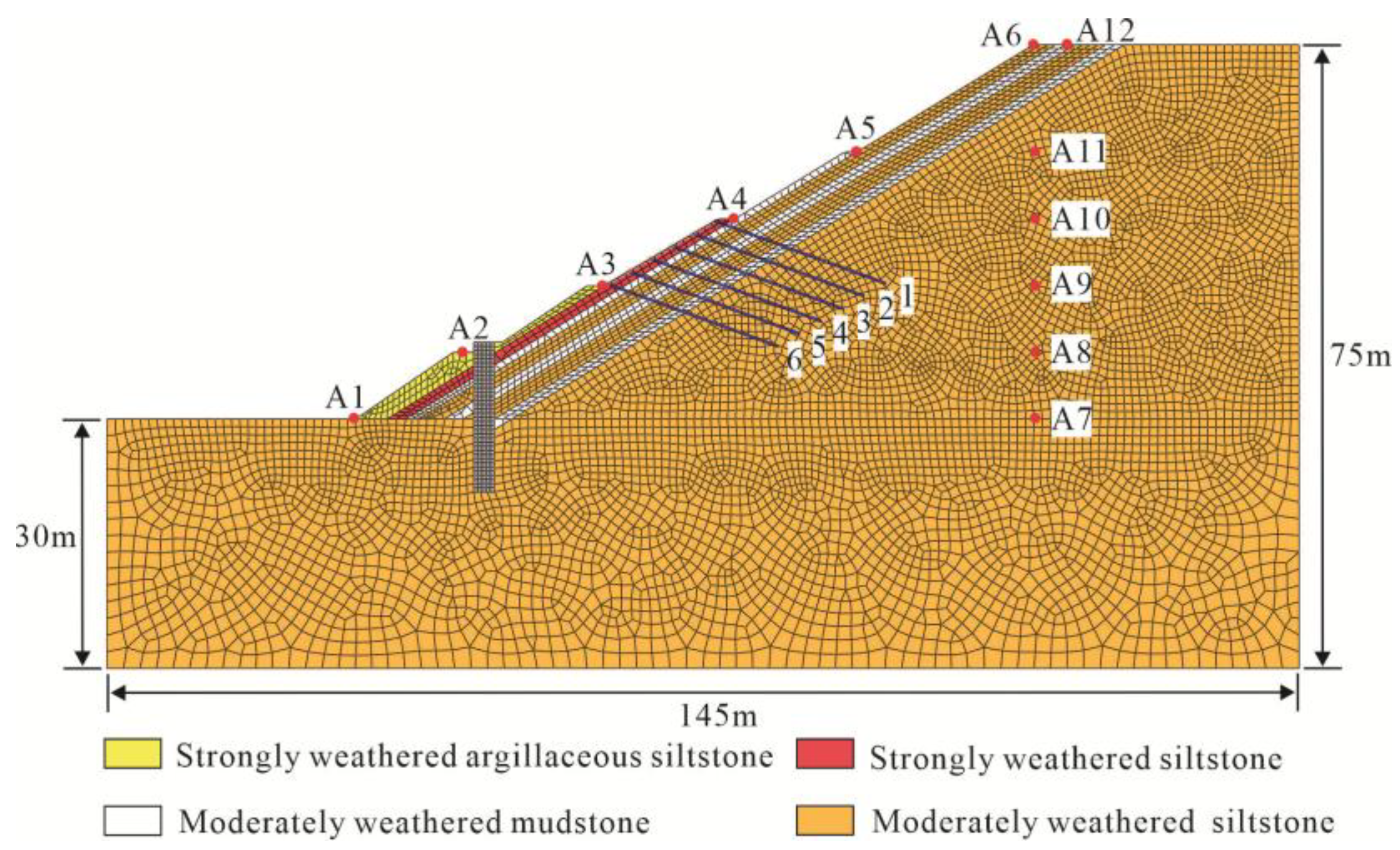
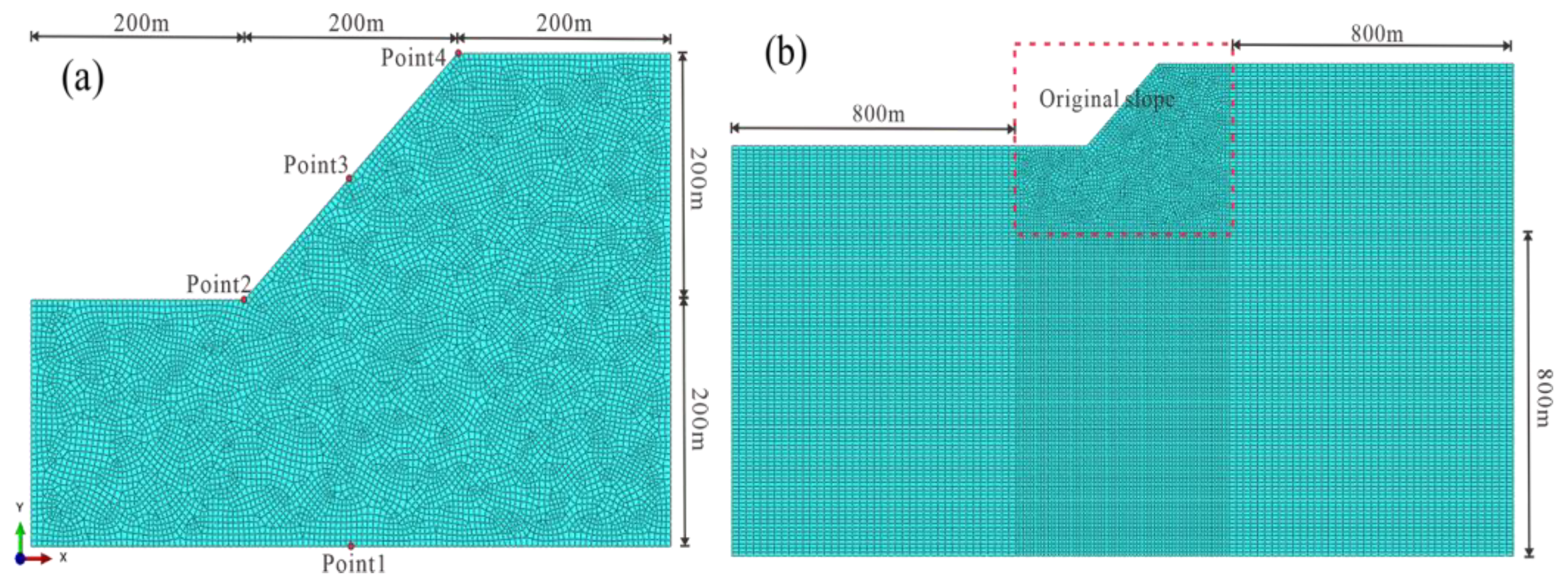
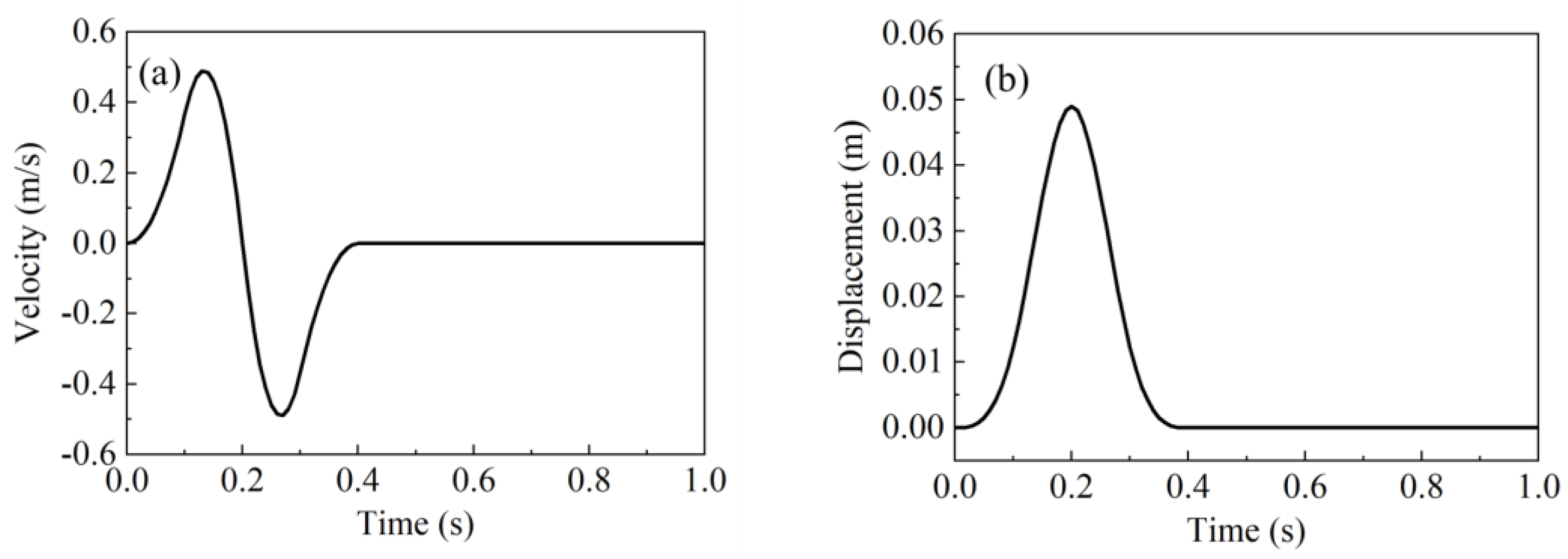


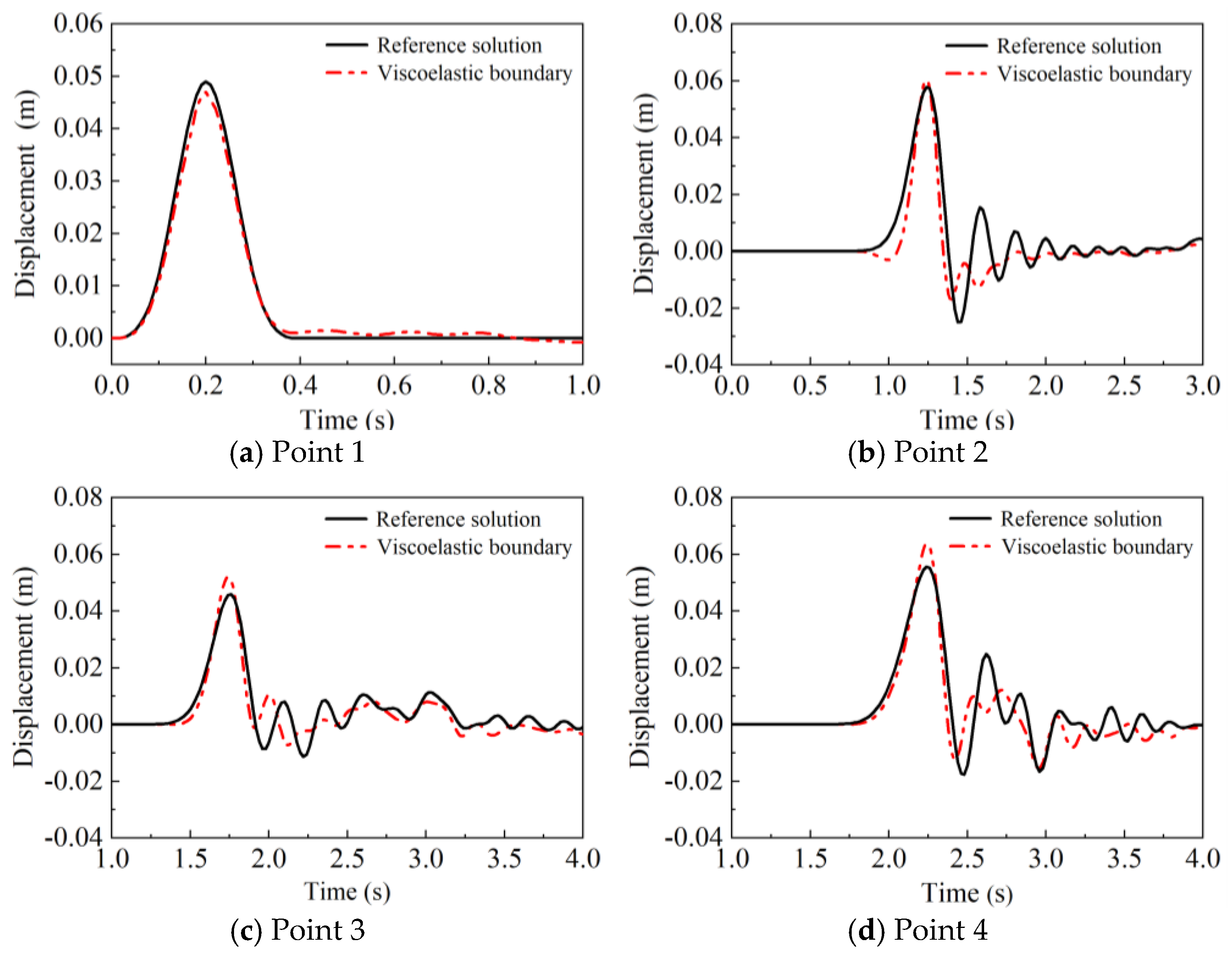
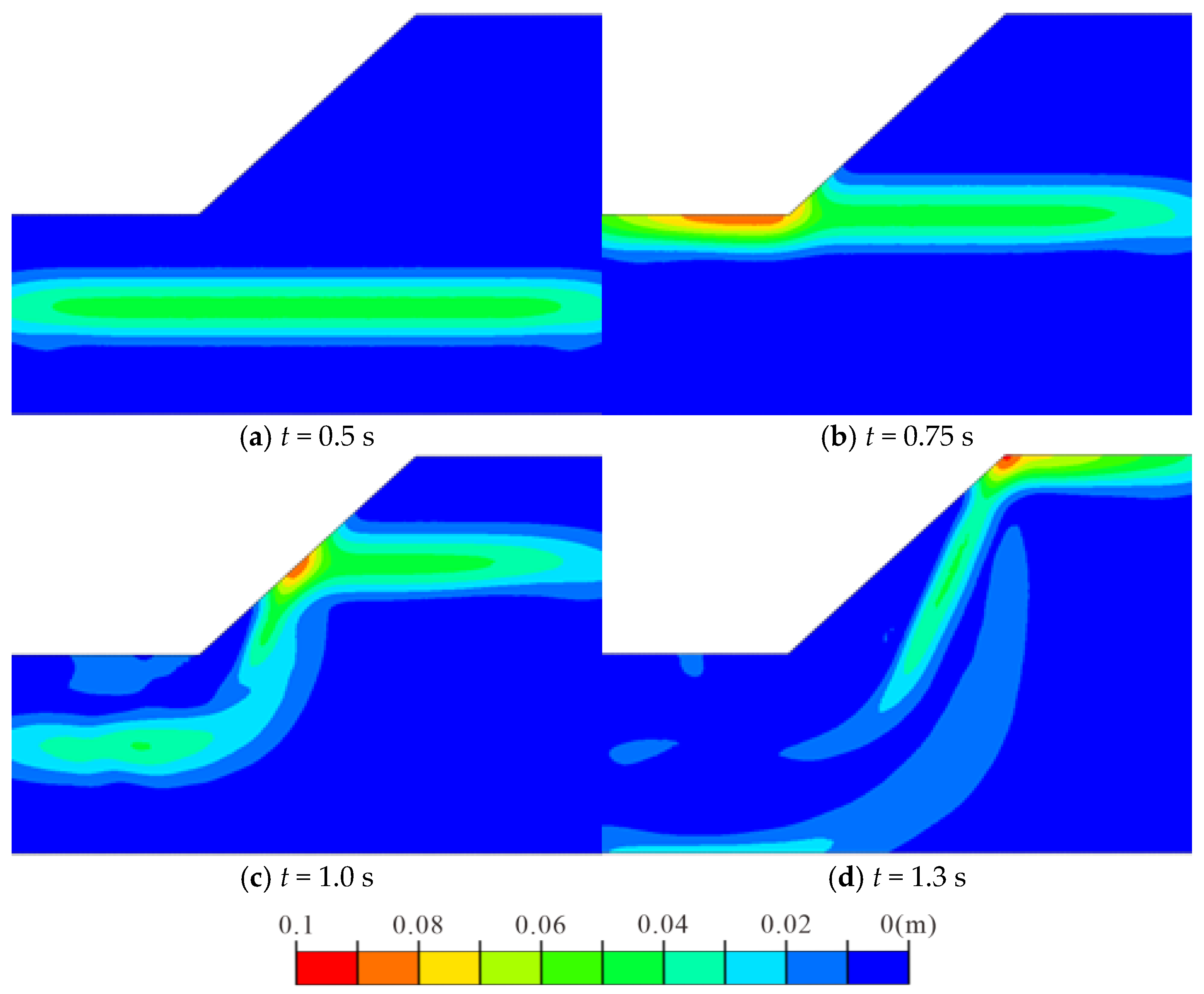
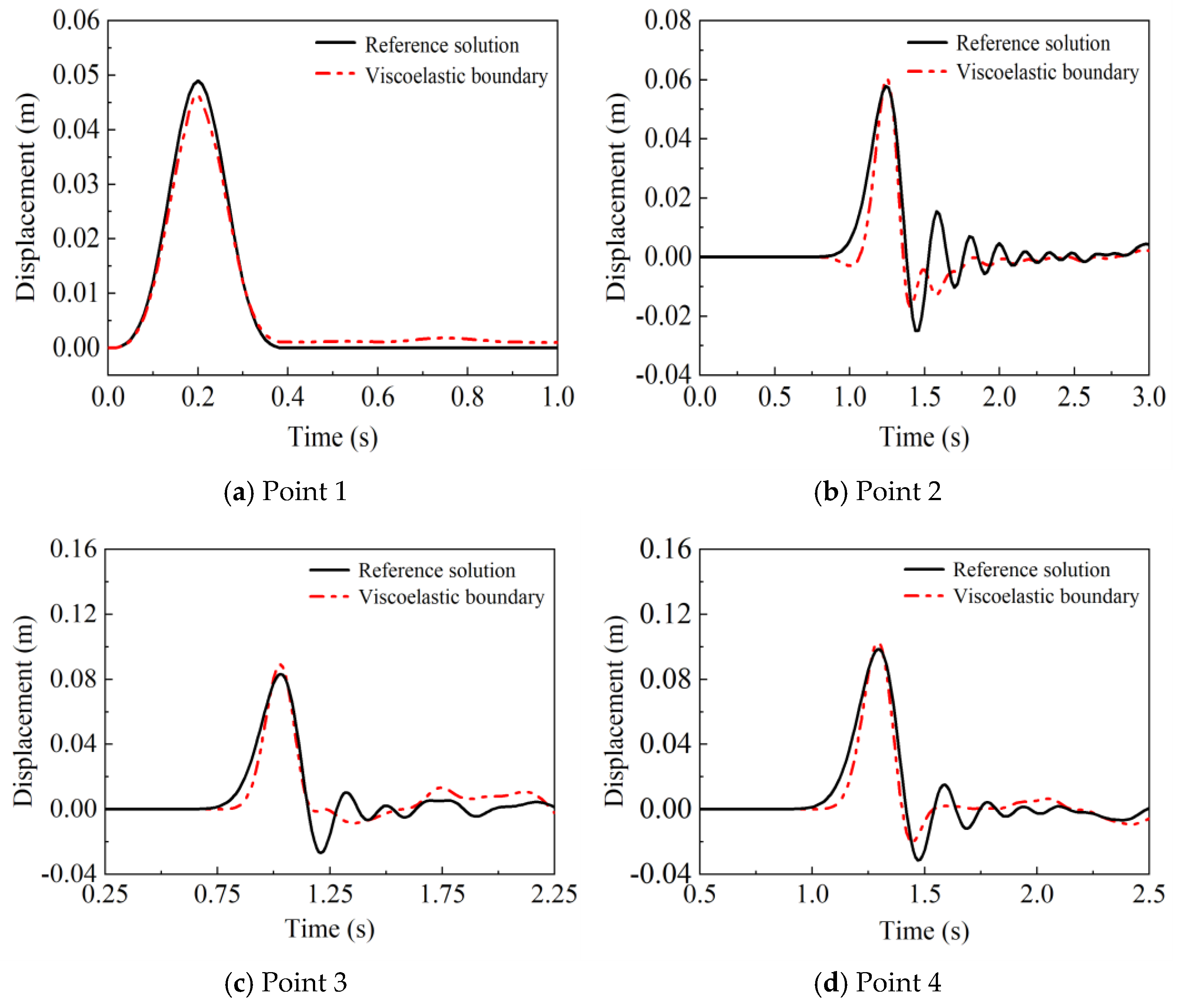
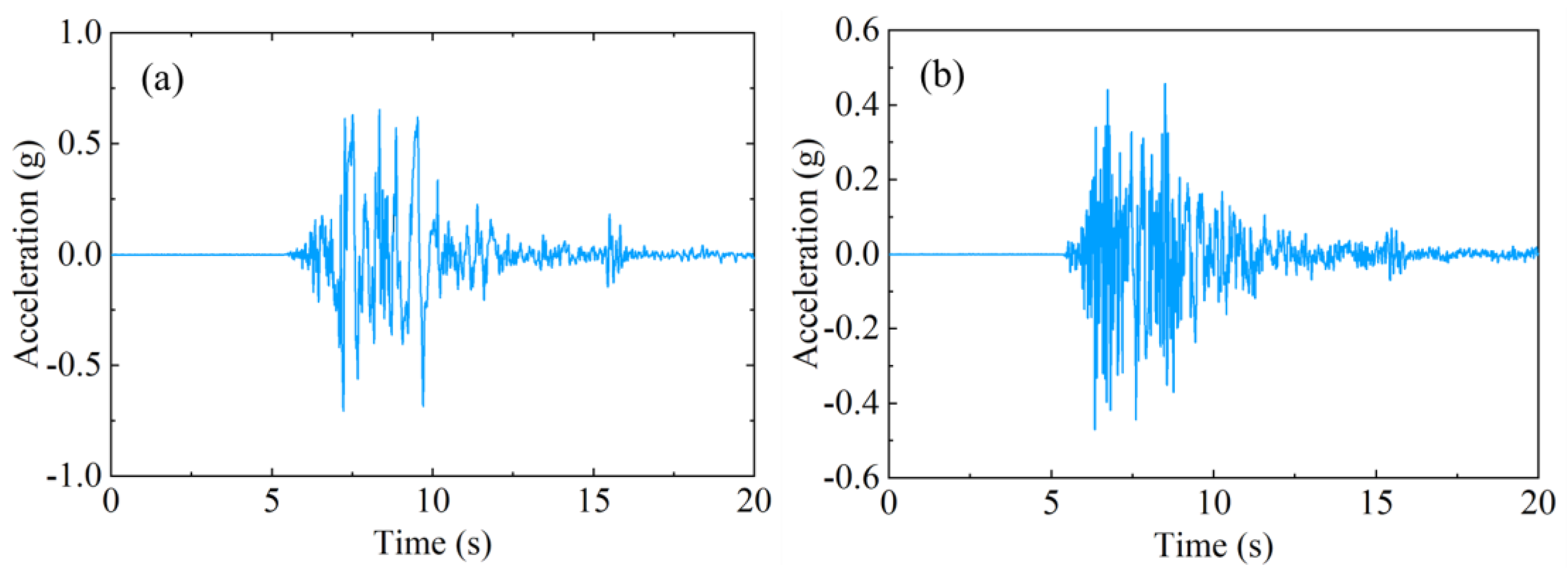

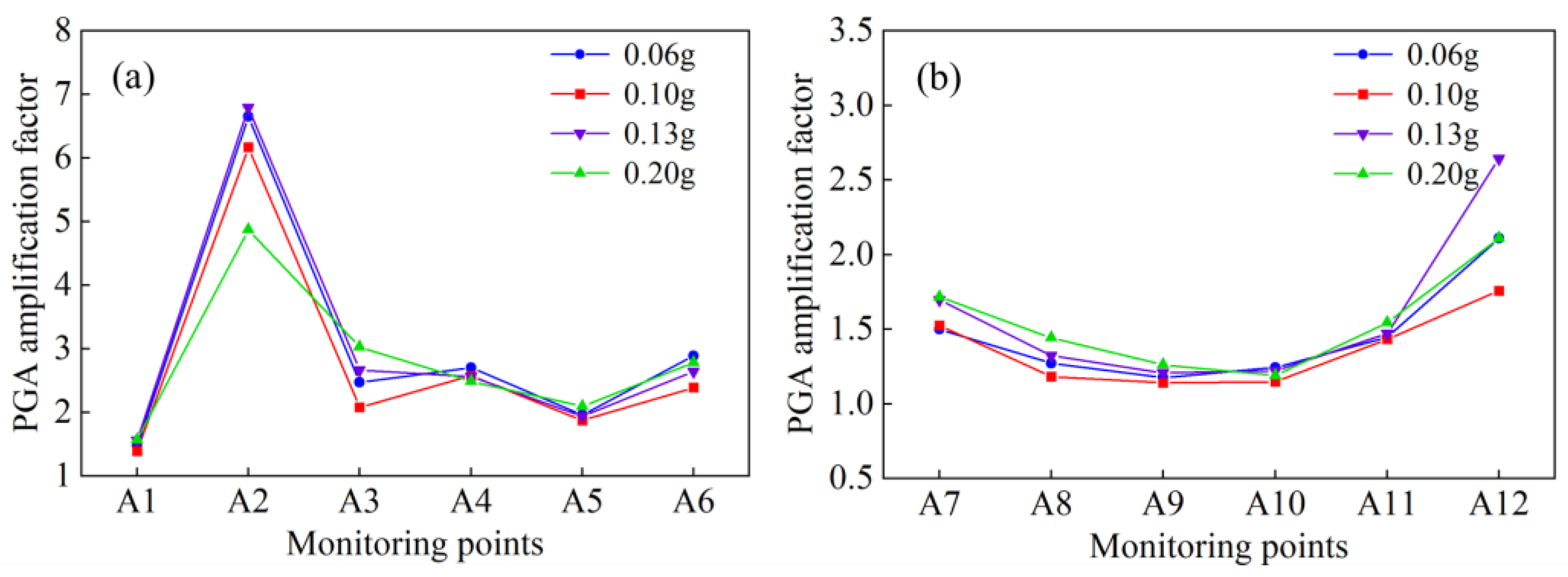
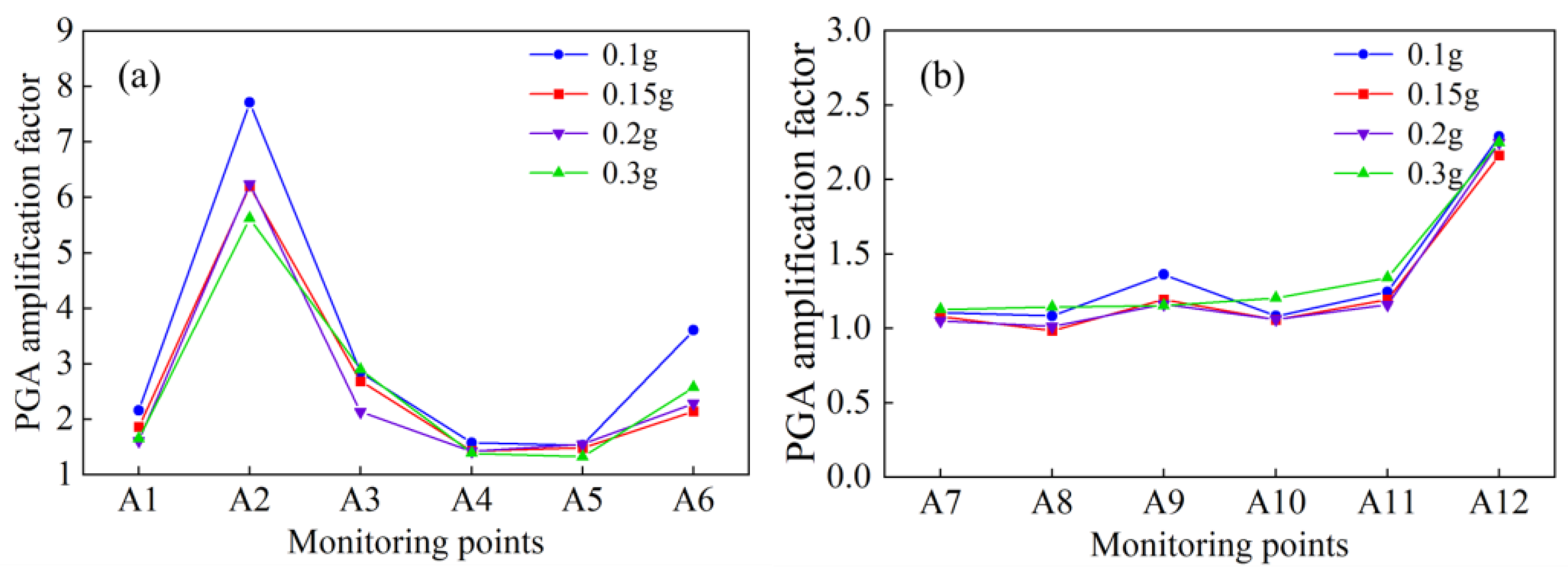
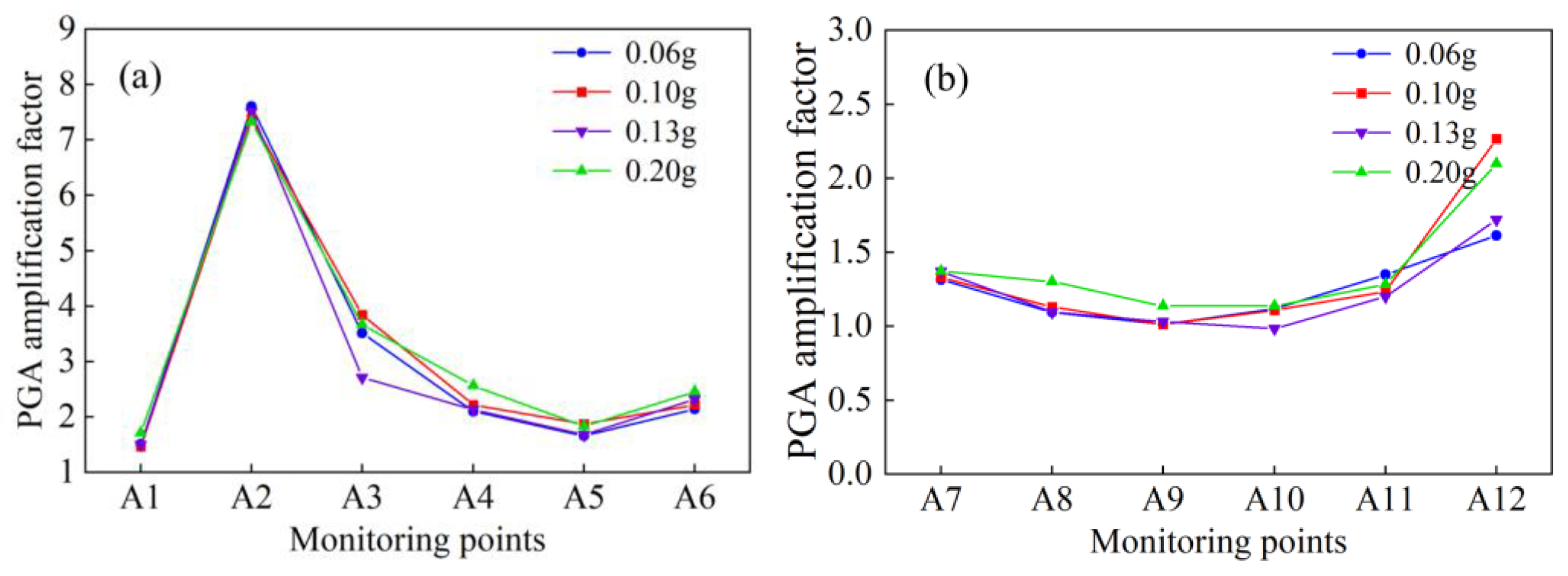
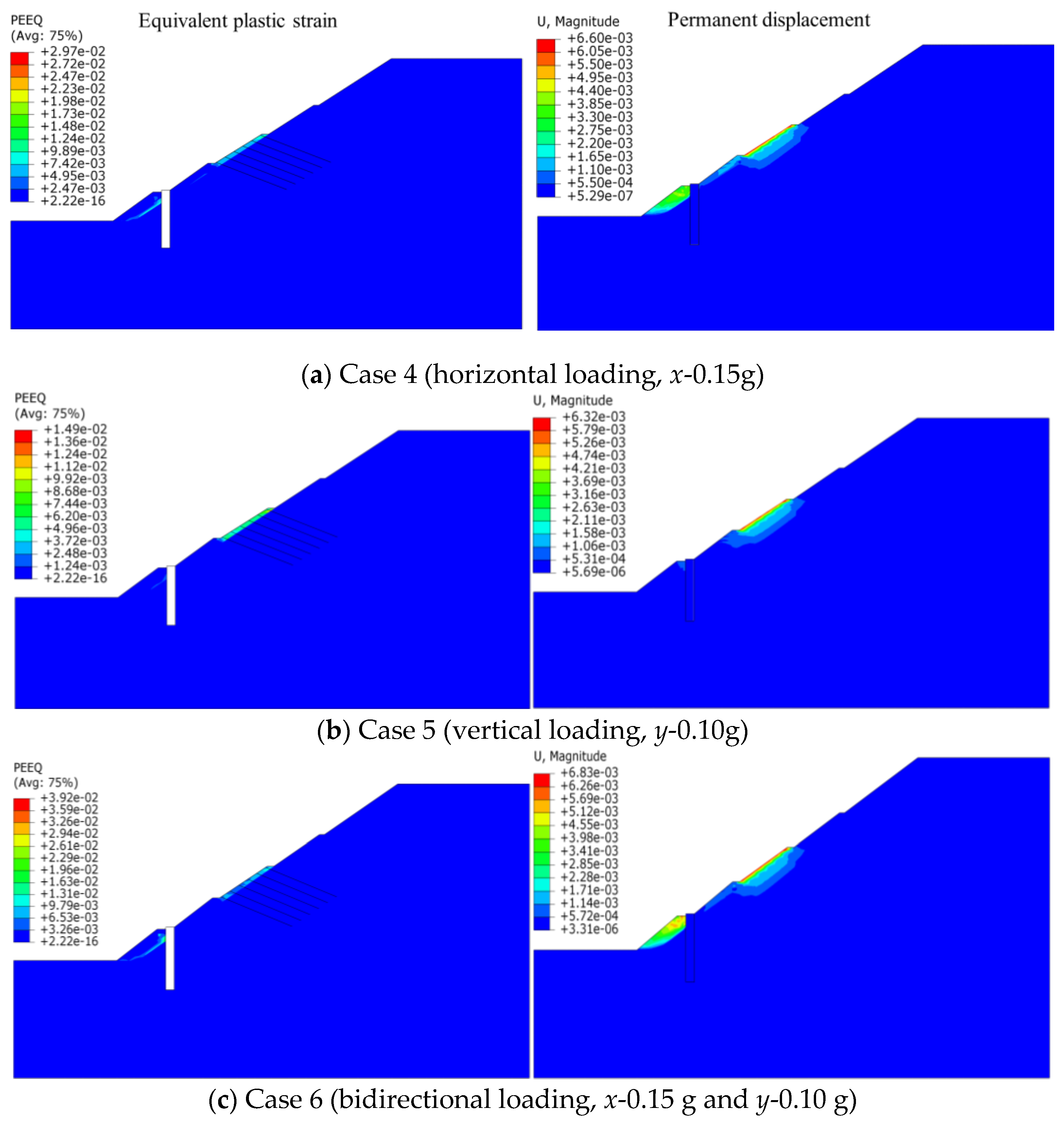


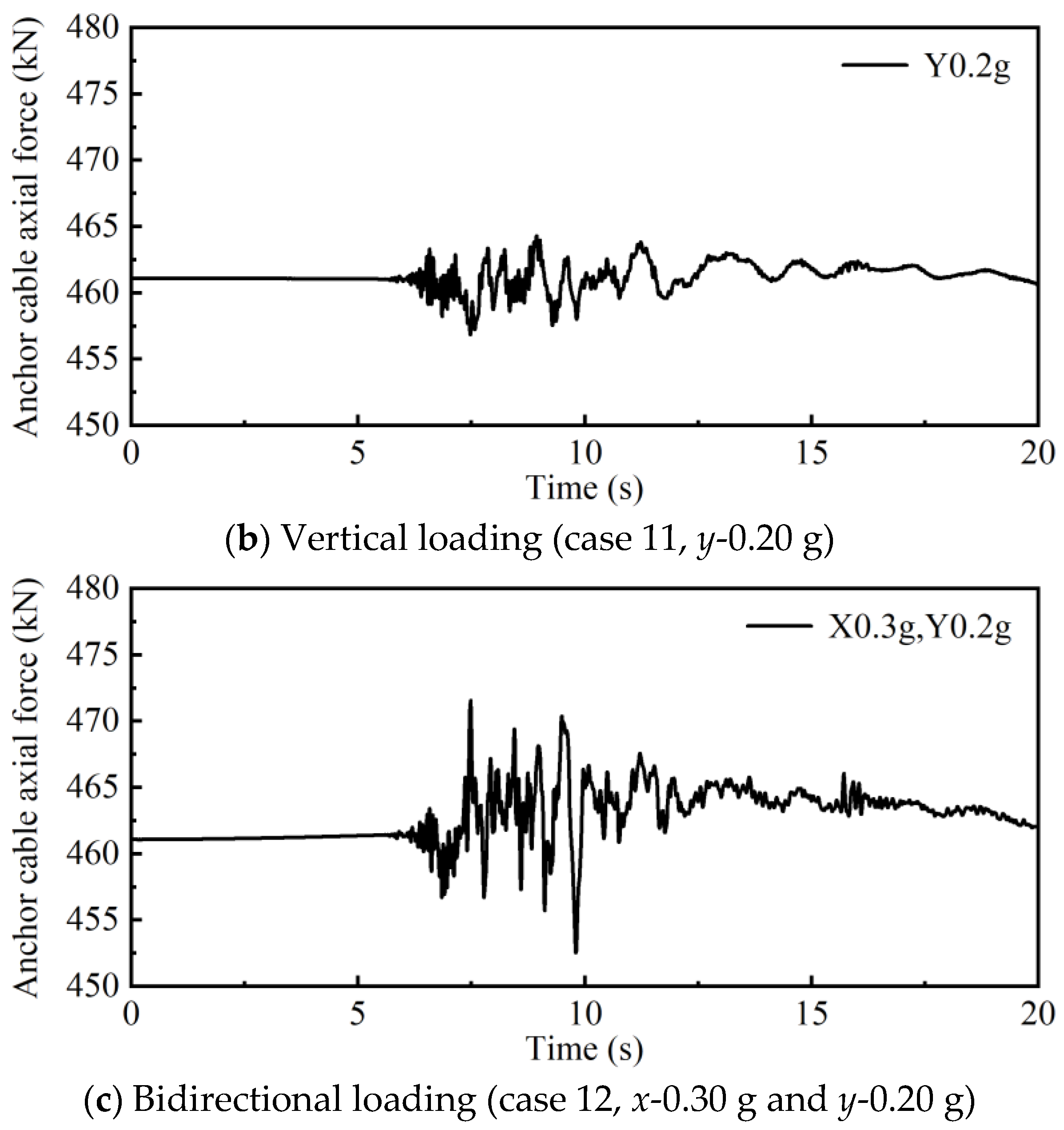
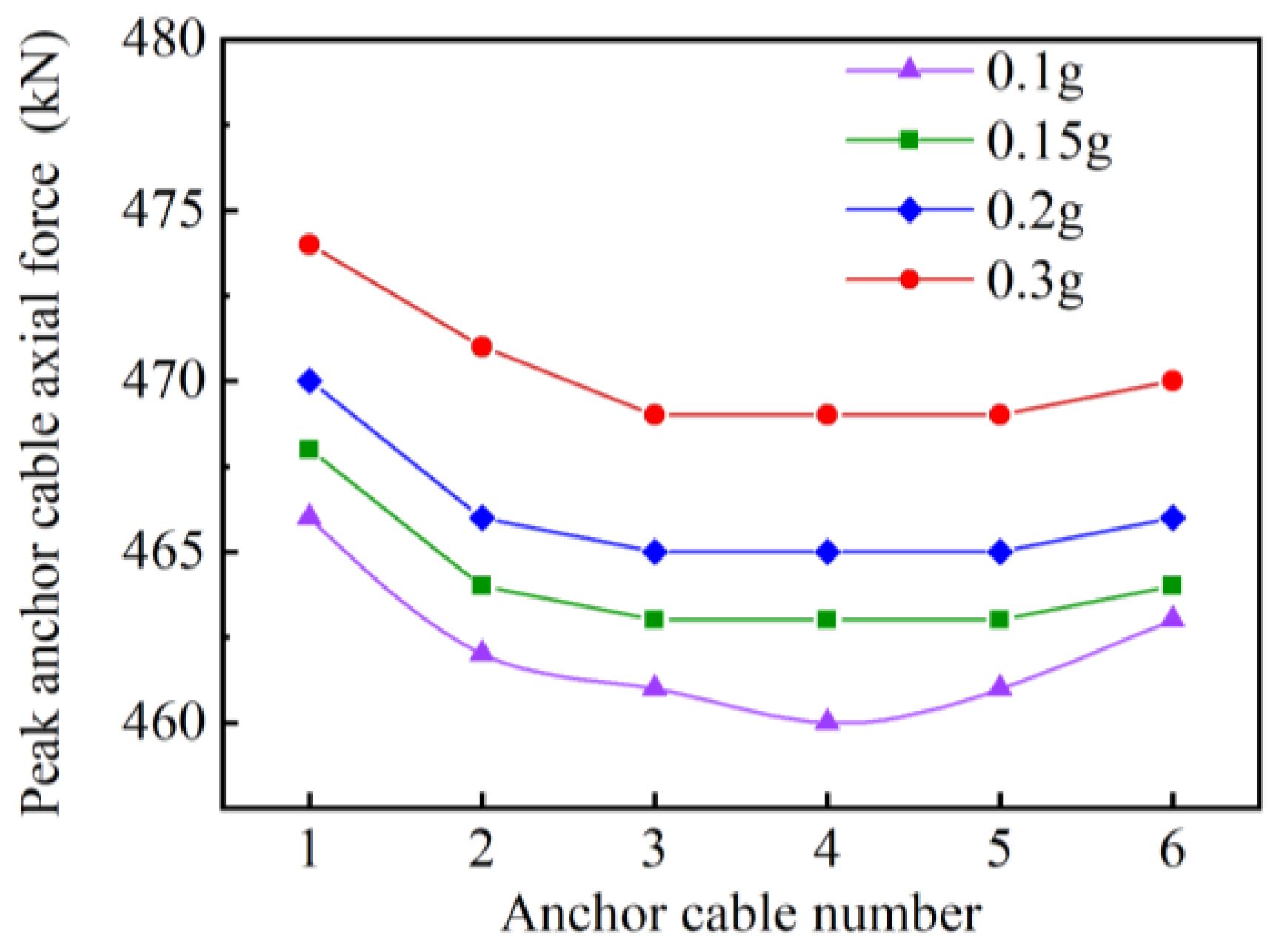
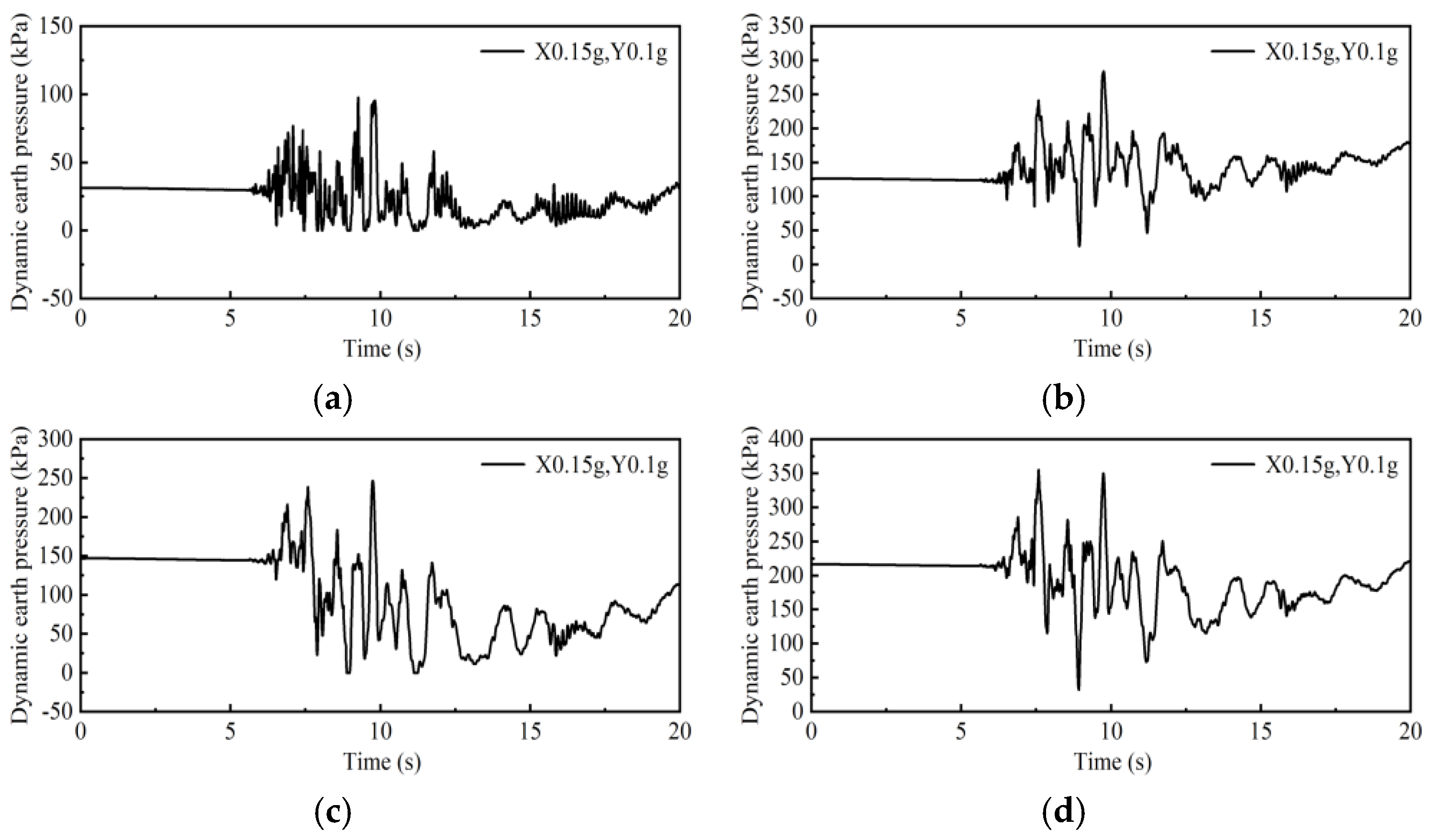

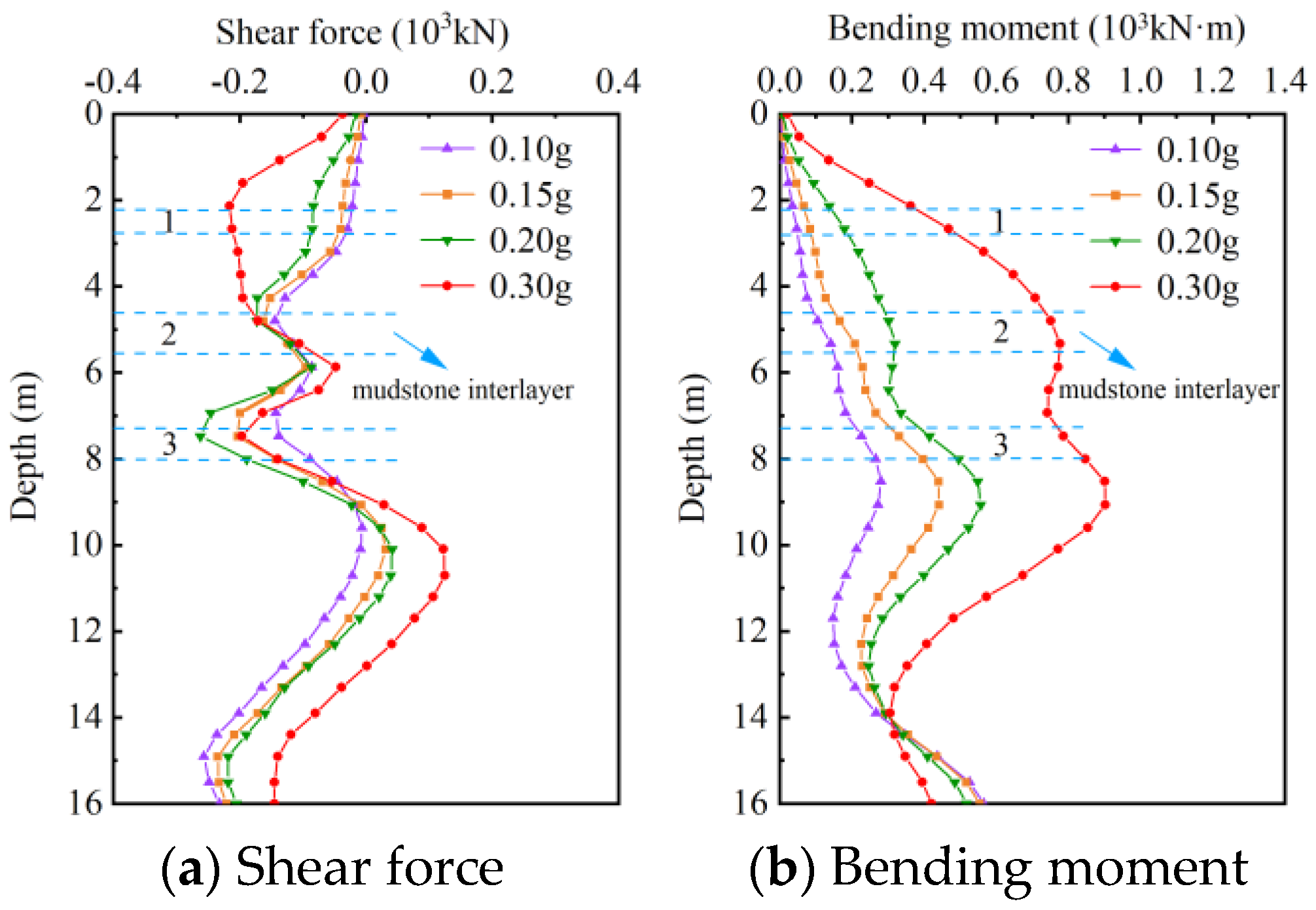
| Number | Time | Longitude | Attitude | Mw |
|---|---|---|---|---|
| 1 | 31 July 1917 | 28°00′ | 104°00′ | 6.5 |
| 2 | 10 October 1948 | 27°06′ | 103°08′ | 5.75 |
| 3 | 11 May 1974 | 28°06′ | 103°54′ | 7.1 |
| 4 | 15 November 2003 | 27°12′ | 103°18′ | 5.1 |
| 5 | 26 November 2003 | 27°12′ | 103°38′ | 5.0 |
| 6 | 3 August 2004 | 27°06′ | 103°18′ | 6.5 |
| 7 | 25 August 2004 | 27°12′ | 103°36′ | 5.6 |
| 8 | 22 July 2006 | 28°00′ | 104°12′ | 5.1 |
| 9 | 7 September 2012 | 27°30′ | 104°00′ | 5.7 |
| 10 | 3 August 2014 | 27°06′ | 103°18′ | 6.5 |
| 11 | 17 August 2014 | 28°06′ | 103°18′ | 5.0 |
| 12 | 18 May 2020 | 27°11′ | 103°10′ | 5.0 |
| Materials | Density (kg/m3) | Elastic Modulus (MPa) | Poisson’s Ratio | Frictional Angle (°) | Cohesion (Kpa) |
|---|---|---|---|---|---|
| Strongly weathered argillaceous siltstone | 1950 | 65 | 0.32 | 19 | 17 |
| Strongly weathered siltstone | 1980 | 120 | 0.3 | 21 | 20 |
| Moderately weathered mudstone | 2100 | 300 | 0.27 | 17.4 | 49.5 |
| Moderately weathered siltstone | 2330 | 2172 | 0.21 | 43 | 1220 |
| Pile | 2400 | 30,000 | 0.2 | - | - |
| Anchor | 7800 | 198,000 | 0.2 | - | - |
| Case | Motion | Acceleration Amplitudes (g) | |
|---|---|---|---|
| Horizontal | Vertical | ||
| Case 1 | Ludian NS | 0.10 | 0 |
| Case 2 | Ludian UD | 0 | 0.06 |
| Case 3 | Ludian NS + UD | 0.10 | 0.06 |
| Case 4 | Ludian NS | 0.15 | 0 |
| Case 5 | Ludian UD | 0. | 0.10 |
| Case 6 | Ludian NS + UD | 0.15 | 0.10 |
| Case 7 | Ludian NS | 0.20 | 0 |
| Case 8 | Ludian UD | 0 | 0.13 |
| Case 9 | Ludian NS + UD | 0.20 | 0.13 |
| Case 10 | Ludian NS | 0.30 | 0 |
| Case 11 | Ludian UD | 0 | 0.20 |
| Case 12 | Ludian NS + UD | 0.30 | 0.20 |
Disclaimer/Publisher’s Note: The statements, opinions and data contained in all publications are solely those of the individual author(s) and contributor(s) and not of MDPI and/or the editor(s). MDPI and/or the editor(s) disclaim responsibility for any injury to people or property resulting from any ideas, methods, instructions or products referred to in the content. |
© 2025 by the authors. Licensee MDPI, Basel, Switzerland. This article is an open access article distributed under the terms and conditions of the Creative Commons Attribution (CC BY) license (https://creativecommons.org/licenses/by/4.0/).
Share and Cite
Wang, K.; Yu, X.; Chu, Z.; Li, Y. Dynamic Response of a Bedding Rock Slope Reinforced by a Pile–Anchor Structure Under Earthquakes. Buildings 2025, 15, 1869. https://doi.org/10.3390/buildings15111869
Wang K, Yu X, Chu Z, Li Y. Dynamic Response of a Bedding Rock Slope Reinforced by a Pile–Anchor Structure Under Earthquakes. Buildings. 2025; 15(11):1869. https://doi.org/10.3390/buildings15111869
Chicago/Turabian StyleWang, Kaiyang, Xianggui Yu, Zhuqiang Chu, and Yanyan Li. 2025. "Dynamic Response of a Bedding Rock Slope Reinforced by a Pile–Anchor Structure Under Earthquakes" Buildings 15, no. 11: 1869. https://doi.org/10.3390/buildings15111869
APA StyleWang, K., Yu, X., Chu, Z., & Li, Y. (2025). Dynamic Response of a Bedding Rock Slope Reinforced by a Pile–Anchor Structure Under Earthquakes. Buildings, 15(11), 1869. https://doi.org/10.3390/buildings15111869






